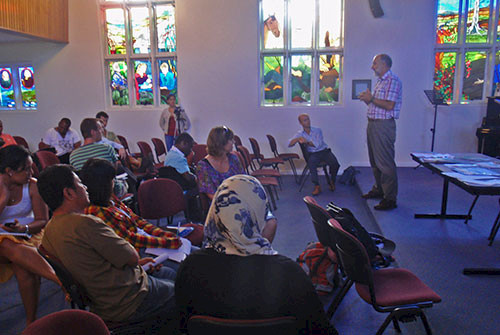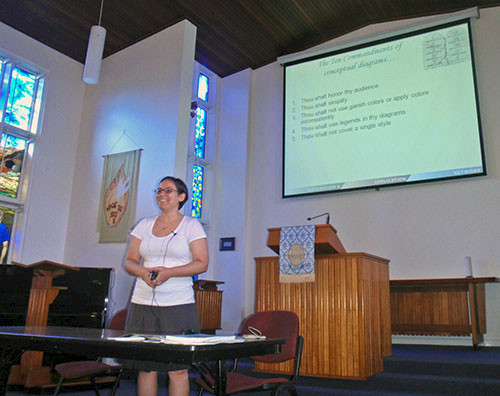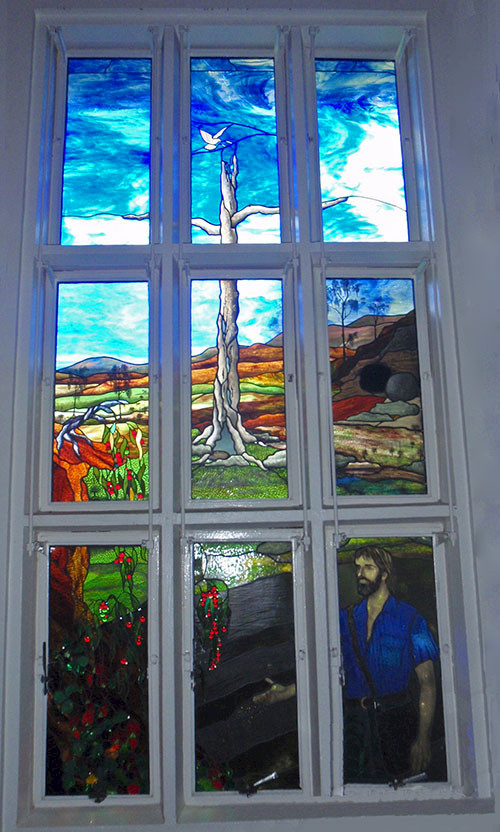Conceptual diagrams in a chapel
Bill Dennison ·For science communication training for the International WaterCentre Masters of Water Management students, we used the chapel of Cromwell College on the University of Queensland campus. It was an interesting venue for this training. My training colleague was Kate Moore, a talented Science Communicator who works as an independent contractor, associated with the International WaterCentre. Following my introduction to science communication, Kate introduced conceptual diagrams. During her presentation, she reviewed the ancient use of symbols that humans have used to depict the world around them. From cave drawings to Pacific Island storyboards to woodcuts used by Victorian Englishmen like Charles Darwin, people have been using symbols to represent objects and activities for millennia. In addition to using symbols, people have been using combinations of symbols to form conceptual diagrams, or thought drawings, for millennia. As Kate was recounting the central role that universal symbols have been used in society as background to the use of modern computational capacity to build and edit diagrams using the Integration and Application Network symbol library, I was admiring the stained glass windows of the chapel. This when it struck me that churches have been using stained glass dioramas to depict significant events in religion for hundreds of years.


I learned from the internet that stained glass was developed by Egyptians and Romans and used extensively in the Medieval period, where they were the major form of pictorial art in society. The different colors of glass were created by adding metallic oxides, like copper to make green, cobalt to make blue, and gold to make red glass. Some stained glass windows in Europe have survived since the late Medieval period, but ironically one of the acts of Oliver Cromwell when he was a powerful force in the British Isles was to destroy stained glass windows. The irony is that Cromwell College, named after Oliver, has created some wonderful stained glass windows. Not all stained glass is used to develop dioramas, some stained glass is simply used in a decorative form, but the large windows at Cromwell College depict parables to honor the founder of the college, V.E. Hancock.
One of the most attractive aspects of colored stained glass is the vivid use of colors, which backlighting from the sun accomplishes during the typical daylight church services. The use of colored glass was developed before color printing became widely available, thus for many people, it was the one example of colorful conceptual depictions that they regularly viewed. Many stained glass windows have been maintained in churches for hundreds of years. A well known glass manufacturer, Louis Tiffany, began to make them for residential use in 1837, often using stained glass in lampshades after the invention of incandescent lights. Stained glass windows with either artificial or natural backlighting provide rich, vivid colors which is one of the reasons they are attractive.

The use of conceptual diagrams using color symbols on backlit computer or data projector displays is the modern version of stained glass windows or Tiffany lampshades. The use of conceptual diagrams in print media is more akin to the hand illustrated books painstakingly reproduced by monks, or the color drawings used in illustrated classic books, where the illustrator would receive acclaim equal to that of the authors.
Another aspect of introducing students to conceptual diagrams as a science communication tool within the chapel led us to use a slide entitled 'Ten Commandments for Conceptual Diagrams'. Our facetious commandments were the following:
- Thou shalt honor thy audience. This commandment refers to the importance of developing diagrams that are appropriate for the intended audience.
- Thou shalt simplify. This commandment refers to the need to keep the diagram relatively simple; using the minimum number of symbols to convey the concept.
- Thou shalt not use garish colors or apply colors inconsistently. This commandment about using colors admonishes the communicator to use appropriate colors, which is particularly important when depicting nature.
- Thou shalt use legends in thy diagrams. This commandment refers to the importance of attaching enough explanatory information to a diagram so that it becomes a self contained visual element.
- Thou shalt not covet a single style. This commandment is an encouragement to try out different styles for the concept being depicted in order that an effective style is selected.
- Thou shall not be constrained by geometry. This commandment allows for exaggeration to be used for communication clarity. For example, vertical exaggeration is typically used in maps, and can be used in conceptual diagrams as well.
- Thou shalt use arrows sparingly. Arrows can be used to denote fluxes and transitions, but should not be used to connect symbols or legends to locations on a diagram. Rather, placement of symbols and the use of a legend can be used to avoid extraneous arrows.
- Thou shalt not be afraid of making new symbols. The IAN symbol library has grown 'organically', by creating new symbols as needed for new conceptual diagrams. The creation of new symbols, conducted by IAN Science Communicators, is an ongoing process, and new symbols can be commissioned.
- Thou shalt use diagrams for peer and non-peer audiences. This commandment encourages the use of conceptual diagrams for scientific publications and for science communication products intended for broader audiences.
- Thou shalt revise, and revise, and revise . . . This commandment refers to the need to revise diagrams repeatedly, just as multiple revisions of text are used to improve the final draft.
We have developed conceptual diagrams in many locations around the globe, and in many venues. But this was the first time that we used a chapel, and I appreciate that this unique venue provided new insights into the history and development of conceptual diagrams.
About the author
Bill Dennison

Dr. Bill Dennison is a Professor of Marine Science and Vice President for Science Application at the University of Maryland Center for Environmental Science.

